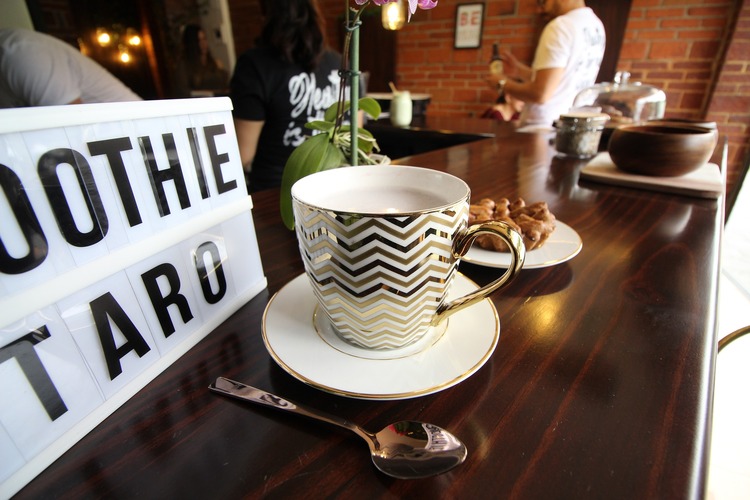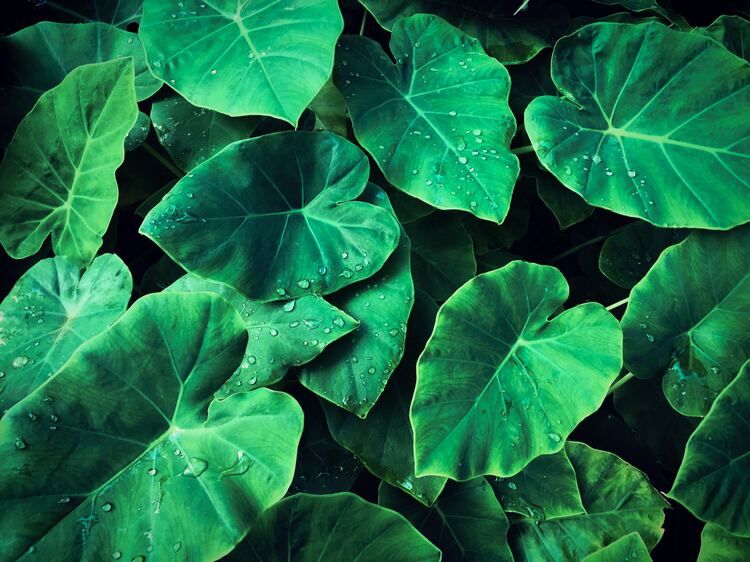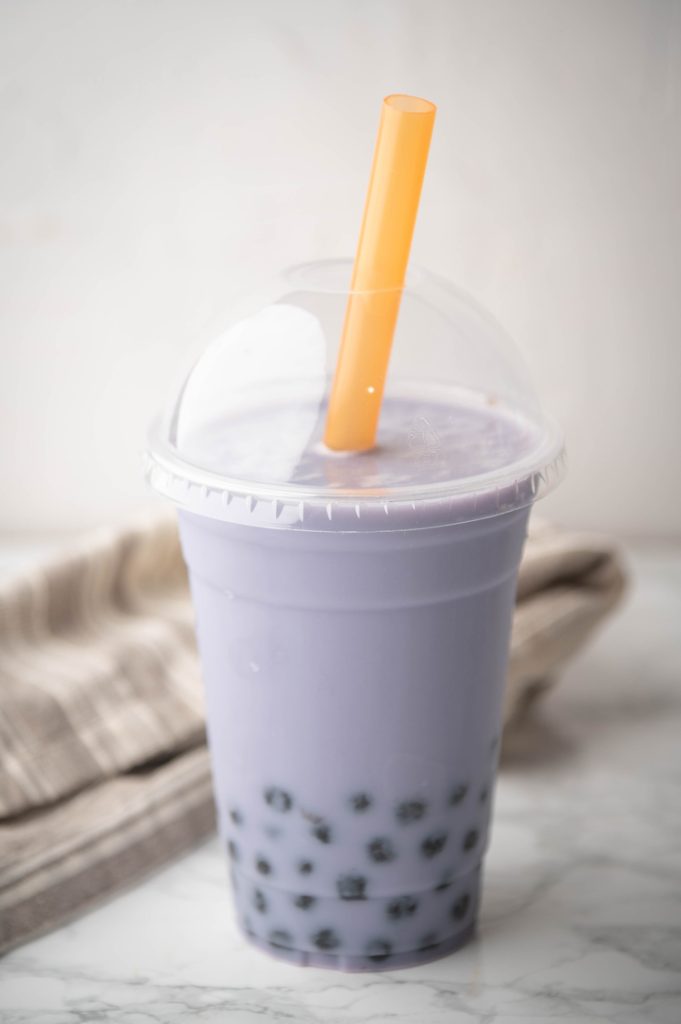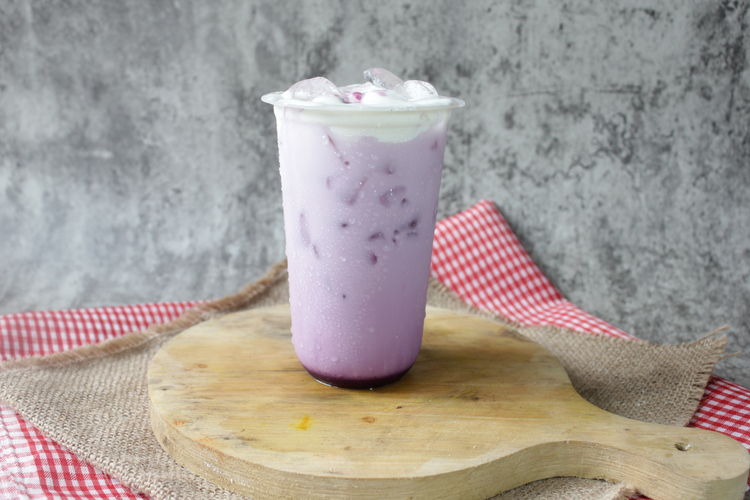Does taro milk tea have caffeine?
Generally speaking, taro milk tea purely prepared with taro powder, milk, and sweetener does not contain caffeine since those ingredients are caffeine free. However, some variations may contain caffeine since they introduce ingredients and toppings with caffeine (for example, black tea, chocolate, etc.).
This article will explore what makes this drink so special. We’ll also guide you through making it at home, and suggest some exciting variations and add-ins. So, if you’re tired of the same old coffee and tea routine, grab your blender, and let’s go!
Please note: This article contains affiliate links, meaning I may earn a commission if you make a purchase by clicking a link. Of course, this comes at no extra cost to you and helps me keep offering readers solid information.

What is Taro Milk Tea?
Taro milk tea is a beverage that originated in Taiwan and has become popular in many parts of the world.
It is made with taro root, which is boiled and mashed to create a thick, starchy paste, and then mixed with milk, sugar, and sometimes additional flavorings such as vanilla or coconut. The mixture is usually blended or shaken with ice and sometimes served with boba (or bubble or tapioca pearls), which add texture to the drink.
Let me mention that taro powder can also be used to prepare the drink. Many coffee and tea houses use taro powder in their drinks. Others use a mix of taro paste and taro powder.
Taro Milk Tea Flavor Profile
Taro milk tea has a unique flavor profile. It typically has a sweet, nutty taste similar to vanilla with a hint of coconut. The taro root, used to make the tea, has a slightly earthy and starchy flavor that gives the drink its distinctive taste.
The milk in the tea provides a creamy and smooth texture, and it is often sweetened with sugar or honey to balance out the earthiness of the taro. Some variations of taro milk tea may include other flavors such as coconut, almond, or chocolate.
Does Taro Milk Tea Have Caffeine?
The caffeine content in taro milk tea can vary depending on its preparation and the specific ingredients used.
Generally, taro milk tea should be caffeine-free as the main ingredients are taro root and milk, which do not contain caffeine.
However, some variations of taro milk tea may contain black tea or other caffeinated ingredients, such as matcha powder, which can increase the caffeine content.
Adding boba or pearls to the drink does not affect the caffeine content.
It’s always a good idea to check with the tea shop or cafe for more specific information on the caffeine content of their taro milk tea.
Note: A lot of times, including black tea in taro milk tea is a given. Therefore, as mentioned above, ask for details before ordering.

Caffeine Content Compared to Other Milk Teas
A 16-ounce serving of black tea milk tea can contain anywhere from 50 to 80 milligrams of caffeine, depending on the strength of the tea. Green tea milk tea typically contains less caffeine than black tea milk tea, with a 16-ounce serving containing around 30 to 50 milligrams of caffeine.
I am providing this information so you can contrast it with caffeine-free taro milk tea. Also, if you add any teas to your taro drink, expect to ingest caffeine in these ranges.
It’s important to note that the caffeine content of milk tea can vary depending on the specific recipe and preparation method, and the amount of caffeine can also vary depending on the type and quality of the tea leaves used.
Benefits of Taro Milk Tea
There are plenty of reasons to switch up your go-to drink and try taro milk tea. As mentioned, it’s a caffeine-free option that can provide relaxation and comfort without the jitters or crashes.
Additionally, taro root is known for its nutritional benefits, including being high in fiber (which can help promote digestive health and prevent constipation), potassium, and vitamin E. Some studies have also shown that taro may help regulate blood sugar levels and improve digestion.
Taro contains vitamin C and other antioxidants, which can help boost the immune system and protect against infections and diseases.
Lastly, taro contains compounds that have been shown to have anti-inflammatory properties, which may help reduce inflammation in the body and alleviate symptoms of inflammatory conditions such as arthritis.

How to Make Taro Milk Tea at Home
Now that you know the benefits of taro milk tea, it’s time to learn how to make a caffeine-free version at home. The good news is that it’s a relatively easy recipe that can be customized.
Ingredients
- 2 tablespoons taro powder
- 2 tablespoons hot water
- 1 tablespoon honey or sweetener of choice (optional or adjusted to taste)
- 1 cup milk (dairy or non-dairy)
- Ice cubes
Instructions
- Prepare Taro Paste (Optional): If you’d like a thicker taro milk tea with more texture, you can prepare a simple taro paste by mixing taro powder with hot water until it forms a smooth paste. Let it cool before using it in the milk tea.
- Make Taro Milk Tea:
- In a glass or shaker, dissolve 2 tablespoons of taro powder in 2 tablespoons of hot water. Mix well until the powder is fully dissolved and no lumps remain.
- Add 1 tablespoon of honey or your preferred sweetener to the taro mixture. Adjust the sweetness to your taste.
- Pour in 1 cup of milk and stir to combine. You can use dairy milk or a non-dairy alternative like almond, coconut, or soy milk.
- If you prepared taro paste, add it now for texture and flavor. Mix well.
- Chill and Serve:
- Add ice cubes to a serving glass.
- Pour the prepared taro milk tea over the ice.
- Stir gently to ensure that the taro paste (if used) is well distributed.
- Taste and Adjust:
- Treat your taro milk tea and adjust the sweetness by adding more honey or sweetener if needed.
- Enjoy: Your homemade taro milk tea is ready to be enjoyed!
By making taro milk tea at home, you can control the ingredients and adjust the sweetness and creaminess to your liking. Also, it is considerably cheaper to prepare the drink at home.
If you are looking for even more taro recipes and ideas, I have articles dedicated to drinks such as taro milk tea (the version here is made with black tea) and taro latte.
Variations and Add-Ins to Try
Once you’ve made a few batches of taro milk tea and are confident in your recipe, it’s time to experiment with some variations and add-ins. Here are a few ideas to get you started:
1. Boba pearls: The chewy, tapioca pearls add a fun texture to your drink. You can find them at most Asian supermarkets or online. Follow the package instructions to cook them and add them to your drink before serving.
2. Whipped cream: A dollop of whipped cream adds a touch of decadence to your tea. You can use canned whipped cream or make your own by whipping heavy cream until stiff peaks form.
3. Coconut milk: For a dairy-free alternative, try swapping out the whole milk for canned coconut milk. It adds a slight tropical flavor and creaminess to your drink.
4. Honey or agave: If you prefer a sweeter version of your taro milk tea, try adding a drizzle of honey or agave to your drink. It will give it a natural sweetness without making it too sugary.
5. Cinnamon or nutmeg: A sprinkle of cinnamon or nutmeg on top of your drink not only looks pretty but also adds a warming spice flavor to your tea.
Don’t be afraid to get creative and come up with your own variations and add-ins. Once you’ve found your perfect combination, sit back, relax, and enjoy your delicious homemade taro milk tea.

Shopping List
We have provided the knowledge necessary to prepare this milk tea at home. Here are our recommendations for the main ingredients.
Qbubble Tea Powder Taro Powder



Black Bubble Tea Boba Tapioca Pearl

Taro milk tea is an excellent alternative to your usual caffeine-laden drinks. Its creamy texture and nutty flavor make it a treat for your taste buds, while its various health benefits ensure that it’s good for your body too.
So why not switch up your beverage routine and give taro milk tea a try? As you savor the unique taste, you’ll wonder why you didn’t try it sooner. As the Chinese Proverb says, “Drinking a daily cup of tea will surely starve the apothecary.” Enjoy!
More About Milk Tea
What Does Milk Tea Taste Like?
What Does Thai Milk Tea Taste Like?
What Does Honeydew Milk Boba Taste Like?
Everything About Tiger Milk Tea
What Does Jasmine Milk Tea Taste Like?